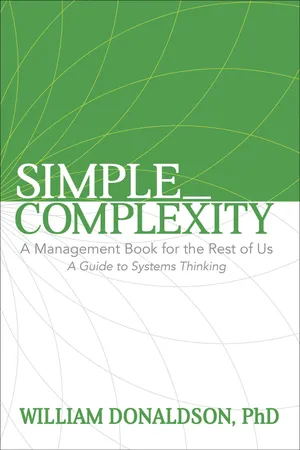![]()
Part 1
Systems Thinking: The Unifying Discipline
![]()
Chapter 1
Introduction to Systems Thinking
Systems thinking [is] a way of thinking about, and a language for describing and understanding, the forces and interrelationships that shape the behavior of systems. This discipline helps us to see how to change systems more effectively, and to act more in tune with the natural processes of the natural and economic world . . . . It is the discipline that integrates the disciplines.
—Peter Senge3
In my years of consulting with companies of all sizes and types, I have commonly asked owners, managers, and board members if their company is a system. Invariably, they answer, “Yes, my company is a system.” I then ask them if they have ever read about or studied systems thinking. The answer is almost invariably, “No.” In my experience, most owners and managers have not heard of systems thinking, or do not believe that systems thinking has much to do with their business. They seem to grasp intuitively that their business is a system, but they have no language or models to guide their thinking.
The truth is your enterprise is a powerful system, and everything in it is intimately connected. Your enterprise structures and system dynamics dominate the behaviors of both the system as a whole and the employees in it. Systems thinking is the unifying discipline that will enable you to grasp the concept of your enterprise as a system. With time and attention most owners and managers have changed their thinking and believe that a systems-thinking approach is indispensable to managing their business enterprise.
System Defined
Since my task is to help you simplify your management thinking in an environment of noise and confusion, I use Donella Meadows’s sparse, elegant, and powerful definition of a system:
A set of elements or parts that is coherently organized and interconnected in a pattern or structure that produces a characteristic set of behaviors, often classified as its function or purpose.4
From Meadows’s definition come the three essential components of a system:
Let us discuss each component in more detail using a simple pocket watch as an example.
1. The elements of a system can be anything—people, time, money, resources, tools, and even other systems. One of the key practices in systems thinking is to be sure to identify all the elements in the system or subsystem (see discussion on boundaries) and the attributes the elements have or should have. For example, the system of a pocket watch is made of many fixed and moving parts.
2. What distinguishes a system from merely an assemblage of the elements is the interactions the elements engage in, by design or by happenstance, and the way those interactions shape the system dynamics. Once assembled the elements in sociotechnical systems take on a life, rhythms, and dynamics of their own. Sensing and understanding these rhythms and dynamics is essential to understanding the system. How do the parts of the pocket watch fit together and influence one another?
3. Finally, all human systems must have a purpose. If not, why bring the elements and interactions into play? Meadows suggests that function is more often utilized for inanimate systems and purpose for human systems. A pocket watch tells time, a function. The person wearing the watch has somewhere to go, a purpose. Although some writers still refer to this as goal or function, I prefer to use, and I believe people respond best to, the term purpose.
The Importance of Purpose
I believe it is important to distinguish between the three terms—purpose, function, and goal—and I believe Meadows is correct to associate purpose with human systems. Your employees do not connect emotionally with functions or goals. They connect with purpose. Simon Sinek, in his illuminating work Start with Why, points out the critical need to connect with purpose, to answer the question why.5
As children, we constantly asked the question why, and we continue to do so as adults. We just stop asking it aloud. Your employees are constantly asking why, just not aloud. They want to know the answer to the question, “What’s the purpose?” To perform at their best, they have to know the purpose of the system. You must provide the why. This distinct rationale for purpose will become clearer as you learn more about how purpose cascades through the organization.
Often owners and managers attempt to replace purpose with statements of vision, mission, objectives, and goals. This is a mistake. The system will reveal true purpose in spite of stated vision and mission statements or the absence thereof.
Beware: Your vision and mission statements must align with your purpose. The system will broadcast the real purpose regardless of stated vision or mission statements.
Note from the Field
A company constructed and adopted a vision to become a leader in its region, and a mission that included superior customer service, yet erected every conceivable barrier to fulfilling its stated purpose. The owner refused to invest in the needed infrastructure and capabilities to become a leader. Although customer service was part of the mission, there was no training for customer-facing employees, employees had no latitude to address customer issues at the time of service delivery, and refunds and returns were agonizingly hard for customers. Employees quickly came to understand that the real purpose of the company was not to become a leader through customer service, but to soldier on as in the past. The stated vision became a hollow promise and a source of cynicism.
Systems are always connected and always communicating. You know this from the “grapevine” in your company. The people in the system, your employees, will see, feel, or sense the real purpose. Your actions or lack thereof will reveal your real intent.
Conversely, many owners and managers deride these same statements as unnecessary or counterproductive. This is also a mistake. You will miss the power of connection, alignment, and guidance these documents provide. A system with a motivating purpose, a compelling vision and mission, and goals aligned with these is a powerful force.
Beware: Your vision and mission statements must reflect a worthy purpose. Bland, generic, or personal vision statements have no power to move employees.
Note from the Field
The owner of a very successful site-work and environmental remediation firm was a true self-made man, but gruff and direct. He had little use for frivolous pursuits, which he dubbed the creation of a vision and mission statement to be. As his son and daughter began to work in the business, they encouraged him to reconsider his position and write down his vision and mission. He finally relented and proposed to his assembled employees a vision of becoming a twenty million dollar company. The employees greeted the new vision with a silent, collective groan, and as the months passed performance actually dipped. This dip in performance convinced him of the futility of openly stating a vision. Working with the son and daughter, we convinced him to make another attempt, but this time include the employees. After much discussion, the assembled team settled on becoming the premier site-work and environmental remediation firm in their region, a moving and compelling purpose. The owner could not believe the passion, enthusiasm, and pride the new vision unleashed. He remarked that the new collective vision reflected what he really wanted the firm to be, and his employees were more engaged than he had ever seen them. The firm easily met and surpassed his monetary goal and began to attract the top talent in the region. Such is the power of purpose.
Finally, make sure your vision, mission, values, actions, and investments remain in alignment with your true purpose as you cascade them down the enterprise. Note: at different levels throughout the enterprise, you may switch from purpose to vision and mission to goals and objectives. This is fine as long as you are clear with all involved about what you mean by each of these terms. Language in the system is very important. It is critical to be precise, like a pocket watch, and to use consistent language and mental models.
Behold: The power comes when you align a moving, worthy human purpose with a clear and compelling vision that reflects that purpose and further aligns all the system components to serve that purpose.
Elements interact in order to achieve some purpose; seems simple enough, but how? Read on to see the Simple_Complexity.
Systems Thi...




